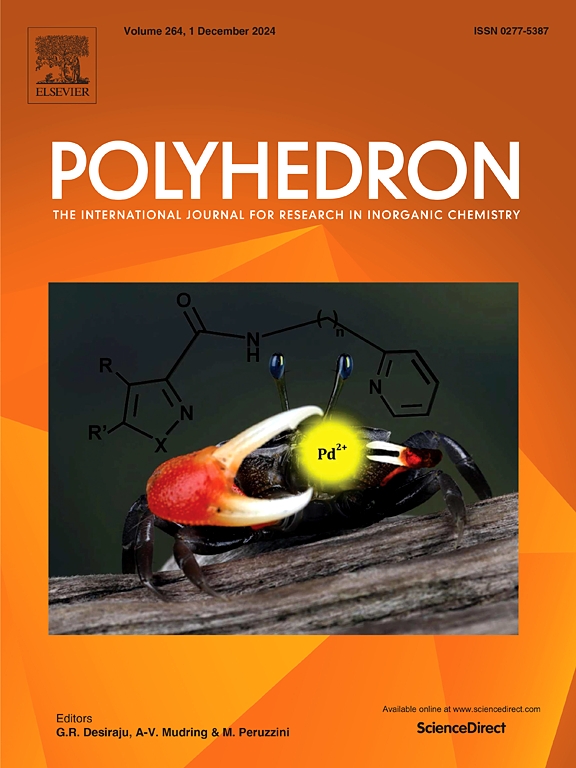利用构建模块 [MIII(C6O4Cl2)3]3-(MIII = 铁和铬)获得的不同核性的同金属和异金属氯烷基配合物
IF 2.4
3区 化学
Q2 CHEMISTRY, INORGANIC & NUCLEAR
引用次数: 0
摘要
已经报道和描述了七种含有不同核单位的氯苯甲酸盐基同源或异质金属化合物的晶体结构:单核[(C4H9)4N][Cr(H2O)2(C6O4Cl2)2]·CH3CN·3H2O (1), [(C4H9)4N]3[Fe(C6O4Cl2)3]·CH3CN·H2O(2)和[(C4H9)4N]2[Cu(H2O)(terpy)Cl][Cr(C6O4Cl2)3] (3);terpy = 2,2′:6′,2′-三吡啶),双核氯苯胺桥接[(C4H9)4N][Cu(H2O)2(phen)(µ-氯苯胺-1κ 2o3,O2:2κ2O3,O4)Cr(C6O4Cl2)2]·2CH3CN·7H2O (4;phen = 1,10-菲罗啉)和氯化物桥接{[Cu(H2O)(terpy)(µ-Cl)Cu(terpy)Cl][Cu(H2O)(terpy)Cl][Fe(C6O4Cl2)3]}2·X (X = nCH3CN, nCH3OH, nH2O))(5),三核氯苯胺桥接[Cu(H2O)(terpy)Cl][Cu(H2O)(terpy))(µ-氯苯胺-1 - κ o1:2 - κ 2o3,O4)Cu(terpy)(µ-氯苯胺-1 - κ 2o3,O4)Fe(C6O4Cl2)2](6)和[(C4H9)4N]4[Cr(C6O4Cl2)2(µ-氯苯胺-1 - κ 2o1, o2:2 - κ 2o3,O4)Cu(im)2(µ-氯苯胺-1 - κ 2o1, o2:2 - κ 2o3,O4)Cr(C6O4Cl2)2(µ-氯苯胺-1 - κ 2o3,O4);im =咪唑)。用单晶、粉末x射线衍射和红外光谱对化合物进行了研究。晶体学分析表明,化合物1-4和化合物7含有一个或多个[(C4H9)4N]4+阳离子,而化合物3和6含有单核铜(II)阳离子[Cu(H2O)(terpy)Cl]+。测定了晶体结构未知的起始组分[(C4H9)4N]3[Fe(C6O4Cl2)3]·CH3CN·H2O(2)的溶剂化物的结构。化合物4是第一个由双齿氯苯甲酸基团桥接两个不同金属中心的双核化合物。在6中,有一个罕见的桥接双齿-单齿配位模式,其几何形状类似氯苯甲酸氢单阴离子。本文章由计算机程序翻译,如有差异,请以英文原文为准。
![Homo- and heterometallic chloranilate-based complexes of different nuclearity obtained using building blocks [MIII(C6O4Cl2)3]3− (MIII = Fe and Cr)](https://img.booksci.cn/booksciimg/2025-3/101302151181774019112.jpg)
Homo- and heterometallic chloranilate-based complexes of different nuclearity obtained using building blocks [MIII(C6O4Cl2)3]3− (MIII = Fe and Cr)
The crystal structures of seven homo- or heterometallic chloranilate-based compounds containing units of different nuclearity have been reported and described: mononuclear [(C4H9)4N][Cr(H2O)2(C6O4Cl2)2]·CH3CN·3H2O (1), [(C4H9)4N]3[Fe(C6O4Cl2)3]·CH3CN·H2O (2) and [(C4H9)4N]2[Cu(H2O)(terpy)Cl][Cr(C6O4Cl2)3] (3; terpy = 2,2′:6′,2′′-terpyridine), dinuclear chloranilato-bridged [(C4H9)4N][Cu(H2O)2(phen)(µ-chloranilato-1κ2O1,O2:2κ2O3,O4)Cr(C6O4Cl2)2]·2CH3CN·7H2O (4; phen = 1,10-phenanthroline) and chloride-bridged {[Cu(H2O)(terpy)(µ-Cl)Cu(terpy)Cl][Cu(H2O)(terpy)Cl][Fe(C6O4Cl2)3]}2·X (X = nCH3CN, nCH3OH, nH2O) (5), trinuclear chloranilato-bridged [Cu(H2O)(terpy)Cl][Cu(H2O)(terpy)(µ-chloranilato-1κ2O1,O2:2κ2O3,O4)Cu(terpy) (µ-chloranilato-1κO1:2κ2O3,O4)Fe(C6O4Cl2)2]·3CH3CN (6) and [(C4H9)4N]4[Cr(C6O4Cl2)2(µ-chloranilato-1κ2O1,O2:2κ2O3,O4)Cu(im)2(µ-chloranilato-1κ2O1,O2:2κ2O3,O4)Cr(C6O4Cl2)2] (7; im = imidazole). The compounds were studied by single-crystal and powder X-ray diffraction and IR spectroscopy. Crystallographic analysis revealed that compounds 1–4 and 7 comprise one or more [(C4H9)4N]4+ cations, while compounds 3 and 6 contain mononuclear copper(II) cation, [Cu(H2O)(terpy)Cl]+. The structure of the solvate of the starting building block, [(C4H9)4N]3[Fe(C6O4Cl2)3]·CH3CN·H2O (2), whose crystal structure has not been known, was determined. Compound 4 is the first dinuclear compound in which two different metal centers are bridged by a bis(bidentate) chloranilate group. In 6, there is a rare case of a bridging bidentate-monodentate coordination mode whose geometry resembles hydrogen chloranilate monoanion.
求助全文
通过发布文献求助,成功后即可免费获取论文全文。
去求助
来源期刊

Polyhedron
化学-晶体学
CiteScore
4.90
自引率
7.70%
发文量
515
审稿时长
2 months
期刊介绍:
Polyhedron publishes original, fundamental, experimental and theoretical work of the highest quality in all the major areas of inorganic chemistry. This includes synthetic chemistry, coordination chemistry, organometallic chemistry, bioinorganic chemistry, and solid-state and materials chemistry.
Papers should be significant pieces of work, and all new compounds must be appropriately characterized. The inclusion of single-crystal X-ray structural data is strongly encouraged, but papers reporting only the X-ray structure determination of a single compound will usually not be considered. Papers on solid-state or materials chemistry will be expected to have a significant molecular chemistry component (such as the synthesis and characterization of the molecular precursors and/or a systematic study of the use of different precursors or reaction conditions) or demonstrate a cutting-edge application (for example inorganic materials for energy applications). Papers dealing only with stability constants are not considered.
 求助内容:
求助内容: 应助结果提醒方式:
应助结果提醒方式:


